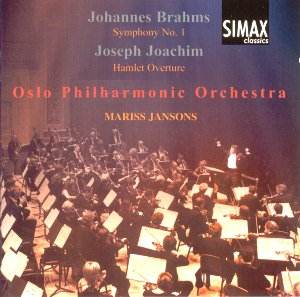Johannes BRAHMS
Symphony No. 1 in C minor Op. 68
Joseph JOACHIM
Overture Hamlet Op. 4
 Oslo Philharmonic Orchestra/Mariss
Jansons
Oslo Philharmonic Orchestra/Mariss
Jansons
 SIMAX PSC 1206
[60.43]
SIMAX PSC 1206
[60.43]
Crotchet
Amazon
UK Amazon US

This is the final instalment in Jansons' Brahms symphony cycle, recorded
live over the last three years by Simax at the Oslo Concert Hall. I have
watched with increasing interest an unfolding set of reviews for the previous
releases which could hardly be more contrasted. The authors of The Penguin
Guide (Yearbook 2000/1), for example, describe the coupling of symphonies
2 & 3 (PSC 1204) as 'among the finest versions of both symphonies …
outstanding'. Bernard Jacobson in the March/April 2000 issue of the American
journal Fanfare says of the same disc 'This … release raises troubling
questions about what it is that constitutes musical talent … Jansons
sounds merely somnolent and unconcerned … the man's reputation is such
that I think readers deserve to be warned.' Clearly something unusual is
happening here, so, as someone who had yet to hear any of these recordings,
I asked our Editor, when this new CD of Brahms First Symphony was released,
to be allowed to review it.
First impressions are not entirely positive. The diffused quality lacks the
necessary open-air quality which Brahms' fulsome sound world always benefits
from. The timpani fail to 'speak' as they should and the winds are somewhat
backward. As to the performance of the first movement, it is clear that Jansons
is fully in control of his orchestral forces and when climaxes approach he
whips up excitement with a sure hand. There remains a nagging feeling, however,
that the extended musical argument employed by Brahms, deploying carefully
constructed, if lengthy, passages of great beauty if not dramatic effect,
does not truly touch a fundamental musical nerve in the conductor. At 12.30,
for example, the climax is as good as you might wish to hear, but immediately
after, at 12.36, the pizzicato passage is disappointingly straight-laced,
with the rubato required almost entirely absent. One searches for
greater plasticity and manipulation from Jansons. Perhaps the very circumstance
of giving a live performance in the not easy acoustic of the Oslo Concert
Hall tells against a successful Brahms recording. Time after time orchestral
attacks appear to be marginally behind the beat, a situation which conspires
to defeat any feeling of forward momentum and inevitably has the damaging
effect of disconcerting the listener who deserves to be taken on a movement-long
musical journey. One result, at 8.22, is a transitional passage that goes
nowhere. More's the pity, then, that Jansons does not observe the all-important
exposition repeat which might have created a better opportunity for building
the argument.
The sensual second movement starts with a beautiful solo from the oboist
(albeit within a rather straightened pulse) but the famous passage (here
at 2.09) where the strings climb up to cascade gloriously downward sounds
rather like a cold shower. Jansons metrical beat allows the clarinet little
room for manoeuvre and, whilst small errors are only to be expected in live
performances, the late entry of the solo violin should have been re-taken
in a patch session. The end of the movement is something of a damp squib
too, with the final violin solo commencing with a very flat note.
Doubtless the grazioso allegretto of the third movement worked its
normal magic with the Oslo audience. The basic tempo is acceptably slow and
there are many felicitous touches in the playing of this fine orchestra.
But again there is a feeling of lack of engagement from Jansons and, in this
movement, in particular, the cool recording does not help.
Matters improve in the last movement as one might expect from a conductor
so admired in the music of the more overtly dramatic composers of the late
nineteenth and twentieth centuries. The rhapsodic nature of this music also
tends to confirm that Jansons is most at his ease here - the more excitable
the music becomes the more Jansons convinces. The pizzicato
accelerando near the opening of the movement is suitably animated
and the principal horn plays out strongly.
But it is all rather too late. The barrage of coughing that punctuates the
entry of the famous string theme (again, surely a candidate for a re-take)
rather spoils the effect and when, nearer the close of the movement, the
theme returns, Jansons finds neither nobility nor sentimentality, one of
which, according to one's taste, should be present.
A great pity then than the much better recorded and played overture by Joachim
finds itself somewhat stranded. Both Brahms and Schumann admired Joachim's
compositional abilities and, although Hamlet cannot be classified
as a forgotten masterpiece, it's well worth an occasional hearing.
Simon Foster

